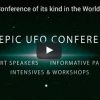NASA Finds Perfectly Rectangular Iceberg In Antarctica As If It Was Deliberately Cut0
- Earth Mysteries, From Around the Web
- October 25, 2018
NASA just shared a stunning image of a nearly perfect rectangular iceberg in Antarctica.

NASA just shared a stunning image of a nearly perfect rectangular iceberg in Antarctica.

For centuries, people have reportedly seen this mythical primate-like animal in the woods of North America.

James Gunn, the last surviving author of the genre’s Golden Age, believes it can help, anyway

The word “HAZMAT” describes substances that pose a risk to the environment, or even to life itself. Imagine the term being applied to entire planets, where violent flares from the host star may make worlds uninhabitable by affecting their atmospheres.

Anomalous experimental results hint at the possibility of a fourth kind of neutrino, but more data only makes the situation more confusing. Katie Mack explains.

Individuals claiming to have seen Bigfoot describe it as a large, hairy, muscular, bipedal ape-like creature, roughly 6 ft –9 ft tall, covered in hair described as black, dark brown, or dark reddish.

Grant Cameron talks about recent history of Disclosure

Around midnight on Oct. 26, 1958, Alvin Cohen and Phillip Small were taking a drive by Loch Raven Reservoir in Towson when they said a great, iridescent, egg-shaped object appeared above a bridge.

NASA’s MarCO mission was designed to find out if briefcase-sized spacecraft called CubeSats could survive the journey to deep space. Now, MarCO – which stands for Mars Cube One – has Mars in sight.

“This is one of the most disturbing articles I have ever read.”






























































